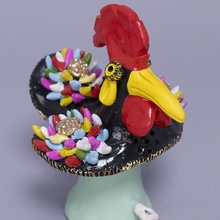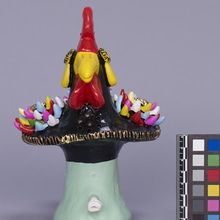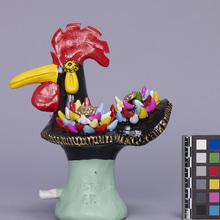Whistle
MOA: University of British Columbia
2956/94
Ceramic whistle in the shape of a black rooster, or cockerel, with a red comb and wattle and a long yellow beak. There are three protruding multi-coloured flowers, one on each wing and one on the tail. There are six holes through the front and one through the back of the whistle.
-
Narrative
Since the 19th century, pottery toys from Barcelos have become ubiquitous throughout Portugal. Today they are more elaborate than the whistles and figures first written about by travellers more than a century ago.
-
Iconographic Meaning
Domingos Côto (1877–1959) made the first rooster in 1935. They soon became the emblematic image of Portugal, buoyed by their popularity and the dictatorship’s enthusiasm for creating a uniquely Portuguese rural decorative style. Ubiquitous toy whistles, widely commented on in the 19th century, sometimes also took the form of roosters. The rooster embodies often stated Portuguese characteristics such as honesty, integrity, trust, and humour.
- Type of Item whistle
- Culture Portuguese
- Material clay, paint, glaze
- Measurements height 19.0 cm, width 15.0 cm, depth 12.5 cm (overall)
- Creator Francisco Esteves Lima
- Field Collector Anthony A. Shelton
- Previous Owner Anthony A. Shelton
- Received from Museum of Anthropology Exhibitions Budget, Anthony A. Shelton
- Made in Barcelos
- Collected in Portugal
- Creation Date during 2011
- Collection Date between 2011 and 2012
- Ownership Date before September 17, 2012
- Acquisition Date on September 17, 2012
- Item Classes ceramics
- Condition good
- Accession Number 2956/0094


